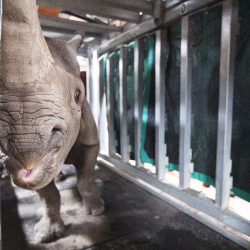Day 13
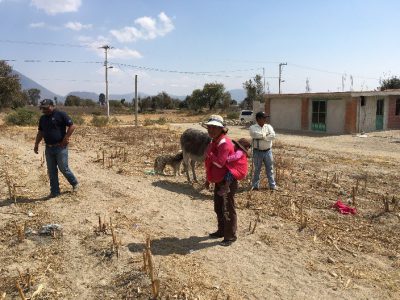
by Jackie Dessoliers
Today was our last day working in rural communities. After another great breakfast, we drove to a small town named San Juan Tepulco in the state of Puebla. As we drove into town, a woman announced over a loud speaker that we had arrived and that people should bring their equids to the field where we would be working. On this final day, we were joined by Angel, another farrier that works for the Donkey Sanctuary and a welcome addition to spare our tired backs. San Juan Tepulco is one of the original communities that the Donkey Sanctuary started working in more than 20 years ago. The community is estimated to have about 1,200 donkeys, mules, and horses, although creating and maintaining a census of the equids had been challenging. The donkeys are mostly used to carry wood and corn from La Melanche, a mountain that's two hours away. In this community, women and children work with the donkeys while the men travel to Mexico City for daily construction work. Many of the women also carried bambinos in sarong-like garments and also had colorful ribbons interspersed in their braided hair.
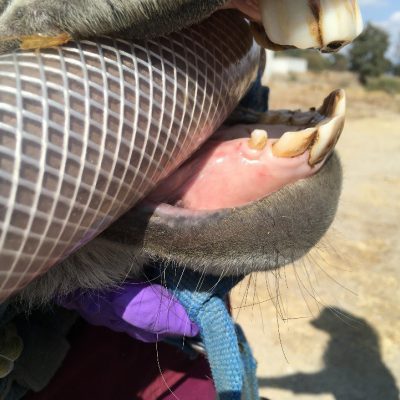
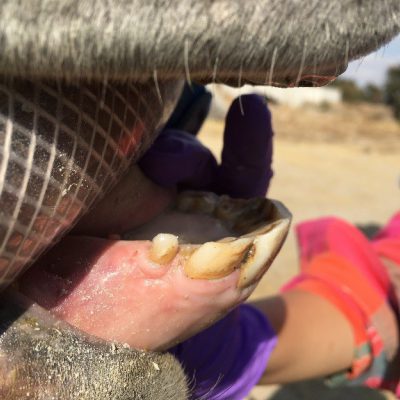

On this final day, Humberto brought out a secret weapon—small laminated cards that were given to the animal owners for their turn! Our day consisted of 20 foot trims, 15 dentals, 1 castration, and deworming (again, we were all out of vaccines by this time). Emily and Bernie also examined a coughing horse that most likely had recurrent airway obstruction (heaves) and provided a good teaching opportunity to review this chronic airway disease (the dusty, high altitude environment was likely a nonspecific exacerbating factor).
Toward the end of the day, a little boy walked into the work area leading his donkey. It was a priceless sight that embodied how important the working equids are to the families that own them and how these animals really are family members. It was a great image to remember all of the time we spent in all of the rural communities.
At the end of the day, we packed up our supplies and headed to a local restaurant where we said goodbye to our fellow UNAM interns and students following the meal. After, they gave some gifts of coffee and tequila for Drs. Schott and Bunn. Then, it was back in the vans for a long ride to Mexico City, where we arrived at our final hotel a bit after midnight—thanks to the General and Luis for driving us safely well over 1,000 miles the past couple of weeks.
Days 14–16

by Lauren Kustas
On Saturday morning, we began our day with a tour of UNAM’s Mexico City campus. The General drove us to campus and showed us around a bit, and then took us down to the Donkey Sanctuary office in UNAM’s Veterinary School. There, José gave us an in-depth description of where the Donkey Sanctuary does its work all around Mexico and how they decide which communities to work with. It was interesting to see behind the scenes of the Mexico Donkey Sanctuary program and to learn more about where the organization works across Mexico and their many logistical challenges.
After this, we met up with Bernie, a UNAM equine hospital intern, who showed us around the equine hospital. The hospital was similar to MSU’s equine hospital with two surgery suites, one for colic surgery and the other for arthroscopy. Both surgery suites had similar padded rooms for induction of anesthesia and recovery, as well as a similar hoist mechanism to lift horses into the surgery rooms. The main hospital had fewer stalls than MSU’s hospital with only one main ward, although there was also an infectious disease ward that we did not visit. Most of the stalls in the main ward were occupied by patients. One of the equine residents was kind enough to give us rounds about the patients in the hospital. The level of care was very similar to what we do at MSU. Patients included a dressage horse that had received a corneal graft, another performance horse that had just gotten a cataract removed, a horse recovering from enterocolitis, another one recovering from a sinus surgery, and an orphan foal. This was a busy time in their equine hospital compared to normal because we their case load is only about 300–400 patients per year (compared to about 1,500 per year at MSU). They also had a horse and a donkey living there. They had been rescued from the slaughter house and were waiting to be adopted.


After touring the equine hospital, we wandered over to the small animal hospital to see if we could find someone to give us a tour. One of the small animal residents was nice enough to give us a quick tour of the hospital, even though it was packed with patients and busy. Although the small animal hospital at UNAM was small and crowded, it had all of the major specialties, even rehabilitation. It was nice to see that they had a separate area for dogs and cats, something that MSU is currently building. Also, it was interesting to learn that they have 22 residents at all times—three for each specialty! Another difference from MSU was that their emergency service only takes patients that have been seen previously at their hospital, meaning they already have a doctor-client-patient relationship for all animals presented on an emergency basis.
Next, Dr. Mariano joined us and gave us a tour of UNAM’s central campus. We had a great snack from a bicycle vendor selling tortas overlooking the large central campus lawn area, where many student events occur. This was followed by some tasty fruit ice cones! Adjacent to this square was the main library, a seven story building covered with a beautiful tile mural by Diego Rivera. From this main square, we then walked over to the old Olympic Stadium where UNAM’s soccer and American football teams play.
Once we were done touring campus, the General and Mariano took us to Coyoacán, a cute little suburb of Mexico City near the UNAM campus. We spent about an hour shopping for souvenirs in a craft market and then all went to a restaurant for dinner. The restaurant had the most amazing melted cheese to put on tortillas! On the way to the restaurant, we saw several stores making churros, so we had to stop at one after dinner for dessert. They were delicious and a perfect ending to the day.
Sunday morning was a free day to rest, and we had a bit of a later start. Five of us decided to go tour the Museum of Frida Kahlo. It was also nearby in Coyoacán and the museum was packed, so we had to wait a bit to get inside. The museum was built in Frida’s home, La Casa Azul (The Blue House). The museum was beautiful, and I learned a lot about Frida’s life, her accomplishments, and her love for her country’s traditions and culture.

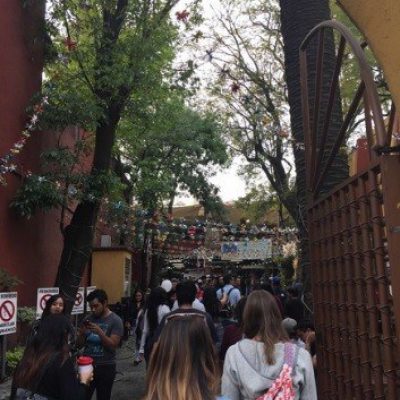
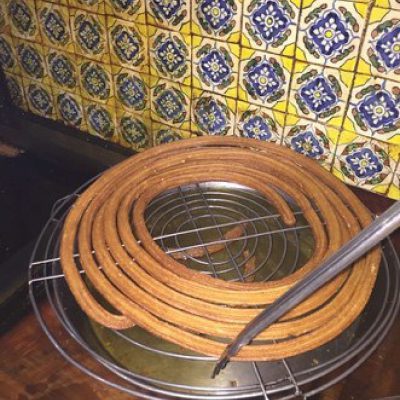
After visiting the museum, the five of us decided to walk around the market that we went to the day before. We bought some delicious salsa and then decided it would be nice to sit down at a restaurant for a while and relax. We found this really cute cantina that looked out over the city square. We each had a drink or two and some nachos. It was a really nice afternoon. When it hit evening time, our group headed back to our hotel where we met up with Dr. Schott, Dr. Mariano and Dr. Elena to watch the Super Bowl in the hotel bar. We were all rooting for the Falcons, so the end of the game was a disappointment for all of us, but it was an exciting game to watch!
Monday was our last full day in Mexico. In an effort to summarize our experience and create a sense of closure, the entire gang (minus Dr. Elena, the UNAM interns, and a few of the UNAM students who were busy working in the hospital) met up to discuss our favorite memories and to reflect on what we had both accomplished and learned during our time together. We sat outside the new contemporary art museum at UNAM for our discussion. All in all, we had examined, vaccinated, and dewormed over 800 working equids in the eight rural communities we visited from Veracruz, through Tlaxcala, and back to Mexico City. We trimmed the hooves of more than 130 equids, we performed 75 dentistries, we palpated 30 mares for pregnancy, and we castrated 20 equids. In addition, we treated many wounds and helped care for other problems. More importantly, we gained first-hand knowledge of the vast need for care of working equids and developed a deep respect for the Donkey Sanctuary mission.
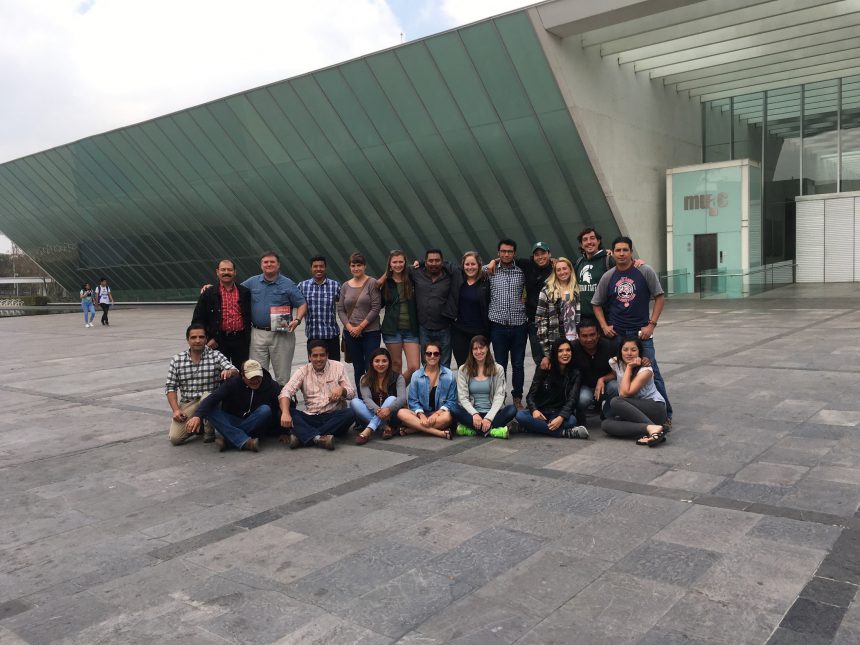
We all felt truly blessed at having helped many hard working Mexican families while at the same time making new friendships with all of our UNAM and Donkey Sanctuary colleagues. The discussion was a nice way to end the program; however, it was sad to know we were about to say goodbye to all of our new friends. The good news is that we have been invited back in 2018 with a new group of MSU students and faculty! We ended our morning with a final group picture and we departed ways with some of the crew while the rest of the group headed to downtown to see the heart of Mexico City.
Downtown, we met up with a large animal internal medicine veterinarian from UNAM (Dr. Maria Masri) and her husband, and ate an absolutely delicious lunch at a beautiful restaurant overlooking the Templo Mayor archeological site. Then, we headed back down to the Zócalo or Plaza de la Constitución (main downtown city square), the original main ceremonial center in the Aztec city of Tenochtitlan. We visited the cathedral and watched as a huge Mexican flag was lowered in the center of the square by soldiers of the Mexican army. We left downtown around 7:00 p.m. and drove around Mexico City for a while with Dr. Mariano as our tour guide, seeing the Ángel de la Independencia statue given to the Mexican people by France in 1910 with gold Lady Victory at the top, and then headed back to the hotel to pack up and get ready to return to Michigan early the next day.


